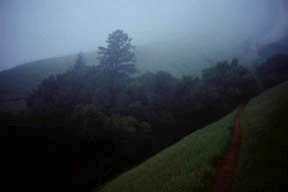






THE ART OF WALKING
Walking is a natural part of picture taking, at least when you’re a landscape artist, and especially when you don’t own a car. I never thought much about it at first, walking was just something that had to be done to collect the imagery I would eventually use in my compositions. I painted plein air for years but always felt a bit uncomfortable when doing so. It wasn’t that I disliked working outdoors; though picking flying insects out of wet paint was not my favorite part, I just became anxious when settled in one spot for too long. Once I found a view worthy of being placed on canvas I would stop and look then wonder what was around the corner or over the next hill. This inborn restlessness led to an obvious choice, use a camera as a sketching tool so I could quickly capture a scene on film and then move on in search of the next. This newfound methodology suited me more than I ever imagined. Along the way I got a lot of criticism from those who felt true artists should not work from photographs. I dismissed all of it. Yes, it is true that relying on photographs changed my perception, but where is that elusive gold standard? There are too many out there fixated on following rules when they would be better off creating substance. The camera is nothing more than one of the many tools I use to create art.

As my walks grew longer and I began seeking out subject matter further afield, they evolved from a way to travel into something closer resembling a ritual. To go out with my camera, whether it be on a city street or in the woods, it became part of an elaborate hunt where stalking, aiming and shooting could no longer be easily divorced from my art. While success in my mind was initially calculated by the number of trophies I returned with, I began to realize that this entire process went far beyond the practical or even profane. While discomfort and pain are never welcome on any journey, I found myself enduring these companions to get the shots I so desperately desired. These were no longer casual walks but a pilgrim’s journey. Everywhere I set my foot became a pilgrim’s path.
To consider art as a verb rather than a noun elevates the relationship between an artist and his audience to a new level. If art is the transformative experience triggered by viewing a work rather than the work itself, can a solitary act of walking alone be considered art? It can if perceived of as a play that is read instead of its performance attended. Evidence must be gathered for this to happen, be it physical objects brought back from the journey, a line drawn on a map, or a photograph taken. This is not new territory for the arts as others have long been on this path. Most however have done this in a strictly conceptual sense, taking care to avoid any connection with the beauty of place that may distract from their conceit. Receding into sentimentality may be a true danger, but I don’t walk as a concept; for me it’s about connecting to real place by looking into its soul, and then translating what I see.
I share my trails these days with dog walkers and those who race past, trying to lose extra pounds or feel the burn. Keeping fit is an admirable pursuit but it is not why I walk or why I’m a good walker. There is another dimension to walking that cannot be overlooked. When art is considered a form of magic, then the art of walking becomes a sacred act in itself, one that requires no audience. I wish to use the word sacred carefully so not to separate it from our day to day lives. The sacred is not something greater, something beyond or apart from us; it can be found in the day to day, in the simple act of walking when we learn to see with open eyes. Walking has been integral to a number of different spiritual traditions from Western Romanticism to the more meditative form of Shugendo once practiced in the East. They do not require additional layers of thought to be placed on walking, they ask the walk to cut through the illusionary layers already heaped upon us. Walking as art and art as magic is not about some otherworldly experience; it is about seeing the real and being open to be transformed by this vision.

SCROLLS
The images on these pages differ from those in the photography section in that taken individually; they do not necessarily incorporate all the qualities I would normally assign to a good photograph. Their presence here should be viewed within the context of a walk, one image chosen for each walk taken. When viewed collectively they take on the appearance of a scroll, implying a greater journey taken and adding meaning to events that were unseen as they unfolded. For years I kept a log of these walks to provide narratives when my work leaned more toward the conceptual. They have since evolved into short narratives, some poetic, some mundane, some relating more to the walk than the image at hand. They are a reminder that these photographs are meant to be more than a pretty picture, that each scroll is a new work of art in its own right.
My walks have been broken down into six sections, each representing a defined place that I have journeyed over an extended period and have grown to have special meaning to me. The opening page starts at the latest entry and runs backwards in time. New entries are posted as walks are taken. Click on the pictures below to open new pages.
THE ART OF TRESPASS
The notion that the deeding of land entitles the owner to exclusive rights to it has never been a universally held belief. Even today there are those among us who think it abhorrent for land to be considered property. In the Americas, where native societies tended to live in a mobile relationship with the land, there were continual conflicts with early European settlers and their notions of proprietorship, which they could not grasp. These early settlers also had many caveats concerning trespass especially after large tracks of common land were divided up. Fencing Laws were widely deployed but only to protect cultivated fields from roving animals. At the same time there was also a wider acceptance of the open use of land that extended beyond the commons. While one was expected to politely stay a respectable distance from the more immediate areas surrounding a home, there was a long standing tradition of walking where you may, provided of course that you did not trample over someone else’s crops or let animals escape from their pastures. Liberty does not negate manners. Many States to this day require burdensome methods of posting land against trespass to discourage landowners from doing so. It has only been in more recent times as we recede into a climate of fear that we are consumed with walling ourselves off from others. Boundaries I have crossed with a wink and a nod are now guarded or sealed. Many of the books by great naturalists such as John Muir and John Boroughs could not be written today for their incessant wanderings would surely land them in jail. Those who walk have often been looked upon suspiciously, even when accepted graciously. Today, walking in certain places has reached the status of a subversive activity.
While I do not advocate the breaking of laws, there is a long history of challenges to them in regard to land rights that must be both acknowledged and respected. Trespassing has largely been a struggle between the landed elite and the landless working classes. In different regions this struggle has taken on different forms. In Europe where the Alpine peaks were controlled by the aristocracy, many rambling societies and pathfinder movements grew strong enough by the late 19th century to achieve access. Walkers in Britain, where most land is privately owned, began enforcing rights-of-ways by overwhelming their opposition in number. While many immigrants to the United States brought the fight for land access with them, they found it was not a foreign struggle on these shores. In New England where beach front property was allowed to extend out past the water line to encourage the construction of wharves, rights-of-way had to be fought over to give fishermen access to the sea.
In the United States where there is more open land to be had, the trend of most walking advocates has been to secure it for public use in the form of parks. While this effort has largely been successful, there is more completion than ever with developers to fill these spaces, and historic rights-of-way are being increasingly illegally blocked. In some cities and towns it has actually become official urban policy to discourage walking by making it as difficult if not impossible to do. Sidewalks are now being privatized in an attempt to eliminate all public space and the rights of citizens to gather that go with them. Besides the need to have a fit body and time, walking above all else requires a place to walk. A good deal of photography also requires a public space from which shots can be legally taken. It is good that so much parkland has been set aside for recreation; it has become increasingly difficult for artists to work in many places where their presence was once ignored. Art suffers for this.
Copyright 2009 Alan Petrulis All Rights Reserved






